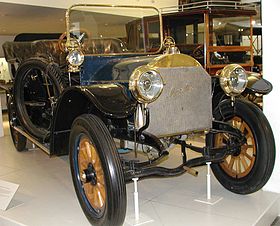|
Mercedes Simplex
The Mercedes Simplex was an automobile produced from 1902 to 1909 by the Daimler Motoren Gesellschaft (DMG, Daimler Motor Society, a predecessor of Daimler-Benz and Daimler-Chrysler). It continued the use of the Mercedes name as the brand of DMG, rather than Daimler. The Mercedes Simplex was designed by Wilhelm Maybach in Stuttgart, Germany. It featured powerful engines whose power ranged from 40 to 60 hp. Its large and wide body had a low center of gravity. A highlight of the Simplex family was the model 60 hp. With this car Mercedes laid the foundation of a new car segment, the super-luxury class with an imposing touring Saloon body, it was unlike anything else at the time and quickly established itself well with royalty and aristocrats.[1] Its immense size and luxuries were to set the milestones for the development of this segment, which was continued on by numerous models over the next 70 odd years, including the 630, 770 Grand, 300 Adenauer and terminating in 1981 with the demise of the 600 Grand. All these models occupied the absolute top segment in the automotive world, along with brands such as Rolls-Royce, Bentley, Cadillac and other demised luxury car manufacturers. The name The car's predecessor, the Mercedes 35hp of 1901, had broken with the previous primitive automotive standards. Now, DMG and Maybach intended to improve this further by providing "comfort by means of simplicity", hence the name Simplex. A complementary explanation for the name is that, by the standards of 1901, the car was very simple to operate.[2] HistoryDMG, Maybach and JellinekThe creation of the previous model, the Mercedes 35hp, predecessor of the Simplex, was due to DMG's industrial might, the know-how of its industrial designer Wilhelm Maybach and Emil Jellinek's enthusiasm for motorsport. Jellinek was DMG's foreign agent based on the French Riviera where he was the Austro-Hungarian consul. That car had resulted in the company's early success. In 1902, Maybach decided to incorporate a series of modifications to the Simplex, anticipating a large number of sales. To suit their basically high society clients, the new Mercedes would be shown publicly "while driving through the most traditional avenues in town or to picnic in a park". Mercedes Simplex as a racecar (1902)When Jellinek received his first Simplex on 1 March 1902 at Nice, he rushed to incorporate it into his Mercedes race team, competing in the Nice-La Turbie hillclimbing race. He defeated all his opponents again and set new records. On 7 April 1902, during Nice week, Albert Lemaître finished second in the Nice – La Turbie mountain race driving a Mercedes Simplex. He was competing in the category for racing cars weighing more than 1000 kg.[3] Also in 1902, in the United States, a Mercedes Simplex won the 5-mile track race at Grosse Pointe, Detroit. In this 1902 campaign, the third step involved William K. Vanderbilt Jr, a US multimillionaire and race car enthusiast who created in 1904 the American Vanderbilt Cup. He had already set several records with the previous Mercedes, in some of the most popular races around the turn of the century, usually long distance ones. Now, with the Mercedes Simplex, Vanderbilt took part in the 600-mile race to Paris. Later, he broke all records in the Ablis to Chartres race with flying start, with a top-speed of 111.8 km/h. One of his Simplex units is the oldest surviving Mercedes car. The German Emperor was a Simplex fanMercedes-Simplex's prowesses were resonating all around the world. More than ever DMG obtained clients among the most important social figures. Meeting Maybach personally at Berlin's automobile exhibition of 1903 Kaiser Wilhelm II of Germany expressed his admiration for the car. Congratulating him for all the achievements at the races, he contrasted these with car's name, commenting: "A truly beautiful engine you have here! But it's not as simple as that, you know." 1902–1909: Remarkable races
Simplex modelsIn 1903, Maybach designed a second version of the Mercedes Simplex, of 60 hp.
DimensionsMercedes Simplex' framework was long, wide and with a low center of gravity, giving an improved stability at high speeds. The wheelbase was extended to 2.45 meters (8'1"). Its carefully designed frame was made of pressed steel. The engine was welded onto it directly, keeping it at a low height. Other general modifications reduced the overall Simplex weight to 942 kg, assuring better results in racing. AxlesThe original 1902 wheels were wooden, with 12 non-removable spokes and pneumatic tires. Later, in 1905, the Mercedes Simplex pioneered cast-steel wheels. The front and rear axles were modernized progressively, becoming equal in diameter around 1909:
Attached to these were the two powerful brake systems, one hand-operated and the other by foot:
Both systems were water-cooled by a sprinkling system over 'hot zones' when braking. Both axles were rigid, featuring semi-elliptic springs. The steering-axles were located at the extremes, decreasing the transmission of road shocks to the driver's hands. Drive systemThe Mercedes Simplex' engine was mounted over the front axle. The engine's power was taken from a sprocket flywheel, 60 cm in diameter, transmitting it to the rear drive by a long roller chain. The 'gate gear' manual gearbox featured four speeds and reverse, controlling a coil spring clutch acting on the flywheel system. A lever produced both declutching and deceleration together. EngineThe engine produced 44 hp at 1300 rpm. Its four cylinders featured:
It used magneto electric-spark ignition system, with single 'spray-nozzle' carburetor, for all cylinders; featuring a new atomization system, improved by preheating. The engine was started up by a hand crank and helped by the use of a decompressor. Maybach's tubular honeycomb radiator featured a rectangular grill of 8,070 square shaped pipes of 6x6 mm, with improved airflow. Originally, when launched in 1902, the Mercedes Simplex radiators did not have a fan. A set of vanes mounted on the flywheel increased the air-flow throughout the engine/radiator compartment. Its total water capacity, 7 litres, was smaller than the previous Mercedes model by 2 litres. The engine compartment was covered by metal sheets. Its chassis base was also covered, something imitated by many other car models later. Surviving cars
See alsoWikimedia Commons has media related to Mercedes Simplex.
References
External links
|
|||||||||||||||||||||||||||||||||||||||||||||||||||||||||||||||||||||||||||||||||||||||||||||||||||||||||||||
